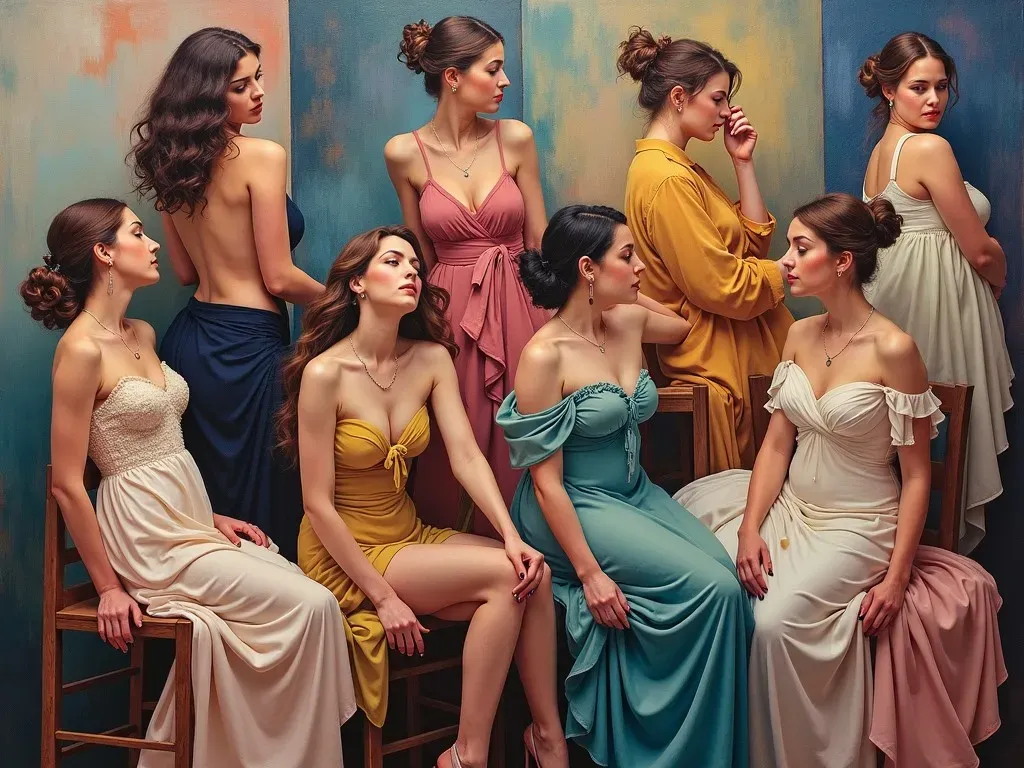The term woman figure painting refers to the art form that focuses on the representation of female figures in various styles and mediums, showcasing the beauty and complexity of femininity through the lens of an artist’s vision. This genre has a long and rich history, evolving from traditional studies in life drawing to modern abstracts, all capturing the unique narrative each artist wishes to convey.
Historical Context of Woman Figure Painting
Woman figure painting has undergone significant transformations throughout history. From the soft, idealized forms of ancient art to the raw, authentic representations in contemporary works, the journey of woman figure painting reflects societal views on femininity and the role of women within art.
Evolution Through the Ages
| Era | Key Characteristics |
|---|---|
| Renaissance (14th-17th century) | Idealized beauty and symbolic representation, often influenced by mythology. Examples are seen in works by Botticelli and da Vinci. |
| Baroque (17th century) | Dynamic compositions with emotional intensity; artists like Peter Paul Rubens celebrated the curvaceous female form. |
| 18th Century Neoclassicism | Back to classical ideals and virtue, with artists like Élisabeth Louise Vigée Le Brun making strides as a prominent female painter. |
| 19th Century Impressionism | Focus on capturing light and spontaneity, leading to more personal and subjective representation of women, as seen in works by Berthe Morisot. |
| 20th Century Modernism | Break from tradition, embracing abstraction and subjective experiences, such as the works of Frida Kahlo and Georgia O’Keeffe. |
Contemporary Woman Figure Painting
In recent years, the genre of woman figure painting has been redefined as more artists, especially women, have entered the field, challenging traditional narratives and aesthetics. Contemporary painters explore concepts of identity, gender, and social commentary.
Notable Contemporary Artists
- Chantal Joffe: Known for her vibrant and expressive styles, Joffe often blurs the lines between representation and abstraction, portraying women in various contexts.
- Cecily Brown: Brown’s works are a dialectic form of femininity, often merging historical art references with contemporary issues about womanhood.
- Jenny Saville: Famed for her large-scale figurative paintings, Saville adopts a bold, provocative style that confronts traditional beauty standards.
Current Art Market Trends
The market for woman figure paintings has grown considerably, with online platforms facilitating the sale and appreciation of this genre. Below is a breakdown of popular platforms where you can find stunning woman figure paintings:
| Platform | Specialization |
|---|---|
| Etsy | Unique, handmade pieces from various artisans. |
| Fine Art America | Original paintings and prints in diverse styles. |
| 1stDibs | High-end, vintage, and contemporary artworks. |
For more insights on current trends, you can visit Fine Art America.
Techniques and Styles in Woman Figure Painting
The approach to woman figure painting can vary greatly depending on the artist’s style, intent, and medium used. Here are some common Techniques employed in this art form:
- Oil Painting: A classical medium that allows for rich color palettes and intricate details.
- Watercolor: Often used for softer representations, watercolor lends a delicacy to the forms of women.
- Acrylic: Versatile and quick-drying, acrylics enable vibrant and expressive works that may lend itself to abstraction.
- Mixed Media: Artists combine various materials and techniques, pushing the boundaries of traditional painting.
Thematic Exploration in Woman Figure Painting
Woman figure painting often delves into themes such as femininity, empowerment, identity, and the female experience, making it a compelling area of exploration for both artists and collectors.
Common Themes Explored
- Body Positivity: Celebrating diverse body types and challenging societal beauty norms.
- Emotional Experience: Capturing the emotional spectrum of femininity through expressions and postures.
- Cultural Commentary: Addressing complex issues surrounding gender roles and the perception of women in society.
Key Examples
- Frida Kahlo: Her self-portraits often explore themes of identity, pain, and feminism.
- Yayoi Kusama: While known for her installations, her paintings also often explore gender and identity through whimsical representation.
FAQs
What is the significance of woman figure painting in art history?
Woman figure painting serves as a historical reflection of society’s perception of women and has evolved to highlight greater themes of independence, identity, and self-expression.
How do contemporary artists approach the subject of the female figure?
Contemporary artists often approach the female form through a lens that challenges traditional beauty standards, exploring broader issues of identity, gender, and empowerment in their works.
Where can I purchase woman figure paintings?
You can find a range of woman figure paintings on platforms like Etsy, Fine Art America, or visit galleries specializing in contemporary art.
Are there famous woman figure paintings that are recognized globally?
Yes, iconic pieces such as "The Birth of Venus" by Botticelli and "Self-Portrait with Thorn Necklace and Hummingbird" by Frida Kahlo have gained international acclaim and continue to influence contemporary discussions regarding femininity.
In the world of art, woman figure painting remains a vibrant and essential genre, with rich historical context and profound contemporary relevance. Through the works of both historic and modern artists, these representations continue to inspire and reshape our understanding of femininity, culture, and identity in society.
